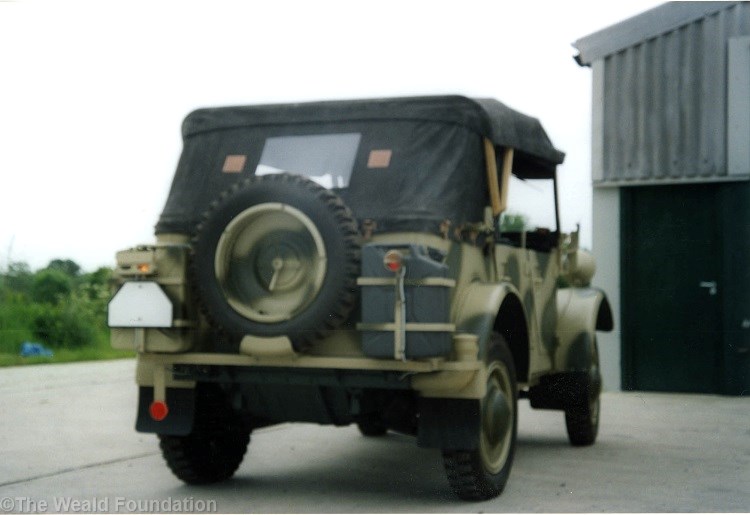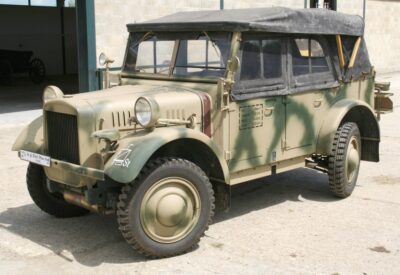This Leichte Gelaendegaengiger Einheits Personenkraftwagen Kfz.1 Stoewer is known to have been in England for approximately twenty-five years prior to its acquisition by the Foundation in 1997. The vehicle originally came from Czechoslovakia where it had been used by a local fire service. A water pump had been mounted at the rear, which explained why the body from the engine bulkhead to the rear was missing. Forward of the bulkhead it still retained its original engine bonnet, radiator, cowling and engine. It was running on incorrect 16” tyres which is not uncommon given the rarity of suitable 18” tyres. During this twenty-five year period, an original windscreen and hood frame were added.
Mechanically, it was nearly complete and in superficially good order. Its post-war use and servicing would have accounted for the better-than-expected condition. A short time after her arrival in England a reproduction body was added, which was very inaccurate in dimension, style, construction and materials.
The vehicle remained this way for many years until the last but one owner managed to acquire several original body parts, including a set of 18” split wheel rims, a skuttle, four side doors, a pair of front wings and two front floor panels. An original 50-litre fuel tank was also found but proved unusable given that it had bad internal corrosion and numerous leaks.
The Restoration
The vehicle was stripped down to its component parts and minor sub-assemblies. The four hubs and axles, the front and rear differentials and the gearbox were all dismantled. These were cleaned and given new oil seals, bearings and gaskets.
The Stoewer’s overhead valve 1800cc engine was not in good condition. After being disassembled it was handed over to a specialist company. It was fitted with a new big end and crank, white metal bearings, new pistons, rings and new cylinder linings. The crank was reground and the crankcase bearings line bored. New valves and springs were added and re-seated and the head and block mating surfaces re-machined. The starter motor was reconditioned, as were the dynamo, water pump, carburettor, remote oil tank and fuel pump. A new stainless steel silencer and exhaust pipe system was added as well as a re-cored radiator.
The cable brakes were fully reconditioned with new brake shoes added. Newly-made 600-18 military pattern tyres were fitted along with new inner tubes and flaps. Original dashboard instruments, various switches and a fuse panel were sourced as well as new-old-stock traffic indicators, windscreen wiper motors and rear lamps. For the headlamps, three badly damaged pairs were cannibalised to produce one good pair. This is a classic example of the difficulties sometimes faced in restoring parts for these vehicles. A newly made rear 50-litre fuel tank and a full set of new wiring looms were added. A “running chassis” had been achieved.
Work then began on the body. All the original parts needed welding, dent-removing and straightening. Many new small fittings were added. Everything was then shot-blasted, finished and prepared for painting. New glass was fitted to the windscreen, with mounting brackets and rubber seal edging. A new rear floor wooden tongue and groove planking was fitted, with some areas covered in steel sheeting. In the trunk, a new steel sheet floor was fabricated with raised steel sections. All of this was an exact copy of the original German style.
This style was common to all three body types used for the le.gl.E.Pkw (leichter geländegängiger einheits Personenkraftwagen ). A decision now had to be taken over which of the three body types should be applied to this chassis. There was no evidence to indicate its original body type, so the choice was open. Eventually, the 4 seat/4 door configuration was chosen.
The entire rear body behind the skuttle, with the exception of the four original side doors, was reproduced. A wooden ash frame with a steel panel covering was fitted. The body was built and finished in the correct style for 1939. This meant it was very different in detail to a 1940 or 1942 lEpkw body. Fortunately, we were able to reproduce and employ the correct construction methodology.
New single front bucket seats and the double-width rear bucket seat were made. Hand built as in the originals, their complex construction involved the use of a number of different materials. The original folding hood frame ironwork was cleaned, repaired and repainted. Unfortunately, woodworm and warping rendered the original ash wood hoops unusable and they had to be replaced. A new hood was produced using period woven flax. All four side screens had the same material stitched around their steel frames.
The rear spare wheel, jack, spade, traffic indicators, spot lamp and rear mirror were mounted with newly made brackets on the exterior bodywork. 20L Benzene Kanister holders were added to either side of the rear-mounted spare wheel. These help to support the rear-mounted lights and number plate and are very common in contemporary WWII photographs of the vehicles.
The vehicle was finished in an overall dark grey (Dunkelgrau ) that was consistent with a vehicle built in 1939. This included a grey hood and side screens. As, however, the vehicle was to be finished in the style appropriate for the 1944 Normandy campaign, two changes were made. Firstly, the 1940 Notek convoy lighting system was added, which required the driver’s side rear lamp to be replaced with the specialist Notek rear lamp cluster. On the front wing, a shaded Notek front lamp was added with two fuses and a Notek resistance switch was added to the dashboard.
Finally, the exterior of the vehicle was repainted in dark yellow (Dunkelgelb ) as per the 1943 German vehicular camouflage requirements and patches of green were added. Suitable tactical and divisional markings were applied. As commonly seen in many contemporary photographs the inside of the vehicle was left grey as was the hood.
Design and Development
The origins of this vehicle type date from the 1928-29 German Army Kraftfahrzeug rüstung programm (literally powered vehicle equipment programme). This provided for the first time a definitive design brief for a military field car, divided into light, medium and heavy categories and additionally defining their usage and equipment levels via the new Kfz. numbering system.
In 1934, Adolf Hitler introduced a widespread rearmament programme for the Army, Air Force and Navy. All were to have new equipment and increased manpower.
For army vehicles, and in particular field cars, this meant the replacement of the previous 1st generation Kraftfahrrungsprogramm vehicles with new light, medium and heavy field cars of the 2nd generation Einheitsprogramm (Standard Programme). Whilst the equipment carried by these vehicles remained very much the same as before the individual light, medium and heavy vehicle designs were radically different. Gone were the specifications based on existing modified civilian vehicles, to be replaced by specifically designed military chassis produced by a small group of manufacturers.
Production
Within each light, medium and heavy grouping one manufacturer was designated as the prime contractor. They were responsible for the initial design, prototypes, trials, and first-run production, plus initiating and controlling any ongoing modifications.
For the lEpkw, the Stettin-based firm Stoewer was chosen in 1936, with BMW of Eisenach and Hanomag of Hanover joining the manufacturing programme in 1937. The only subsequent difference between these three manufacturers was the use of their own engines, albeit of a similar cubic capacity and dimensions.
First Production Vehicle Technical Specifications
This design of the light field car had permanent 4x4 drive, and optional four-wheel steering. This was changed to two-wheel steering only from late 1940 onwards. Large 600-18 tyres, 12-volt electrics, a 5-speed ZF gearbox and all-round independent suspension were also standard. Apart from the engines, every individual component supplied to Stoewer, BMW and Hanomag came from a common source.
These were costly and complex vehicles although significant savings were made by having one chassis design. The story of the engine was different. In all five engine designs were used during its production from 1936 to 1944
Equipment Variations
The bodywork was constructed along traditional lines using a wooden framework covered in sheet steel, and also standardised to be either 4 seats/4 doors (general use Kfz.1 or survey equipment Kfz.3), 3 seats/3 doors (radio, telephone Kfz.2 or maintenance tools Kfz.2/40), or 2 seats/4 doors (twin MG flak Kfz 4). All these variations had steel doors, side screens, bucket seats, fold-down windscreens and folding hoods.
WWII Usage
These vehicles were used throughout WWII on all fronts and approximately 17,500 were built. BMW and Hanomag ended production in late 1940. Stoewer continued until April 1944.
The Einheits field cars were also given the slang name of “Kübelwagen”, as were all the previous and subsequent field car programme vehicles. Originally this was Kübelsitzewagen , and applied to all the earlier Kraftfahrrungsprogramm . To compensate for the sparse bodywork the crew seats were of a wrap-around design commonly known in racing and sports car circles as “bucket seats”. Kübelsitzewagen literally means 'Bucket Seat Vehicle', usually shortened to Kübelwagen or Kübel .
- This article has 1619 words
- Reading time: 8 minutes
- There are no photos
Become a Member - Access the Full Article
Members gain access to the full content of our articles, including photo galleries.


